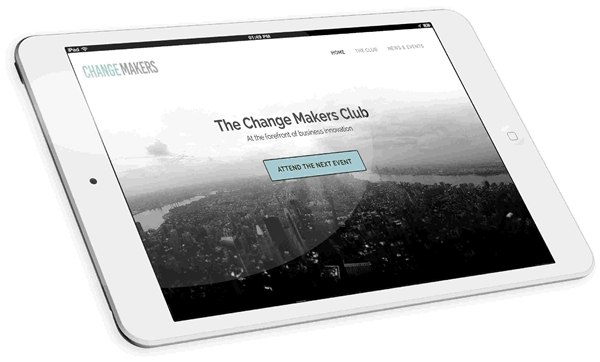If you have a very specific offering that solves a very specific issue for enterprises—or for any size organization, for that matter—then you can probably consider yourself a "niche player."
Your strengths lie in your agility. While bigger organizations have to cut through corporate red tape to get to market, you can test new approaches and react to feedback quickly.
Because those larger competitors are usually better established with broader offerings, however, they usually have strong, strategic relationships in place with senior decision-makers.
Of course, I'm talking about the C-suite.
We all have dream clients—company logos we'd love to place on our homepage. The only way to get there, in most cases, is by engaging with senior decision-makers over time—starting right now.
As a niche player, you already have a specific problem you can solve. That in itself places you in a very strong position. So if you want to engage with the right senior people in your target organizations, here are three ways you can begin connecting with them.
1. Find one specific message to lead with
When most salespeople target the C-suite, they start their messaging with what they do, followed by the benefits and business case, and end by attempting to establish trust.
But that isn't how the C-suite works. If you want to engage with senior decision-makers, you need actually to run the above process in the exact opposite order:

The C-suite don't care about what you do, or even the benefits that it brings. It cares about the issues that are pressing to its members and what business can be done in the boardroom.
To find the challenges that are really hitting them in the gut, we use a process called SCQA:
S: Situation
C: Complication
Q: Question
A: Answer
To build an effective message, you must start with the Answer. It should tie directly with your own value proposition. So first go to the top and figure out the Situation that your target C-suite audience is facing, followed by the Complication that the situation brings. The Question is what ties those challenges to your value proposition.
The resulting answer/message is what you should lead all of your C-suite marketing efforts with.
Here's an example of what I mean:
- Situation: "2014 was a poor year for security professionals. Over the last 12 months, virtually every sector across the globe has been hit by some type of cyber security breach (Sony, etc.). CISOs are responsible for information security and the natural response is to tighten control..."
- Complication: "Despite the obvious need for heightened security, the modern CISO faces a paradox—a boardroom demand for impenetrable security paired with an employee request to be relaxed in the face of modern technologies..."
- Question: "How do I provide greater access for employees while also improving visibility control over key entry points in order to protect key assets?"
- Answer: "One way of getting around this dilemma is by using privilege identity management. This solution allows you to assign a level of access to each privilege account and monitor for access requests/activities that are out of character."
As you can see, the challenge of IT security as outlined above is connected directly with a specific solution. This is the most effective message framework you can use to lead your efforts when engaging with senior businesspeople.
2. Seek an independent stance
We've talked about the importance of independence when marketing to the C-Suite in an earlier article. Independence is especially important for niche players.
You see, even if you drive home a message that focuses on their challenges, you're still coming from the stance of a vendor. A recent Harvard study found that the C-suite spends only 2% of their time with vendors, so how do you get around that?
You build an independent brand.
Coming from the stance of an independent brand that exists solely to deliver value to the C-suite will remove certain barriers of skepticism. It goes beyond the typical buyer-seller dance and connects with C-suite executives on a direct, one-to-one level.
This means building relationships based on intimacy right now, even if they don't want what you're selling yet.

How do we do it at our company? We create independence in the form of a club brand. The club exists to discuss the challenges discovered in the SCQA analysis and to bring peers together. It gets awfully lonely at the top, and the club gives them a chance to have their assumptions confirmed or challenged.
And, yes, your club can (and should) have a digital presence, but it's nothing without a face-to-face element. Intimate relationships are built in person, which brings us to our next point...
3. Engage with the C-suite face-to-face
As I noted, you can't build intimate relationships through digital channels alone. LinkedIn Groups and content marketing have their place, but they go only so far.
You need to bridge the gap and bring your target C-suite executives together into a room. The idea is to create a discussion and generate advocacy.
That's why we use dinners as our "event" of choice.

We choose dinners for several reasons. First of all, dinners bring you into the world of the C-suite outside of its usual working day. Decision-makers are thinking less about execution and more on top-level strategy—which is a perfect setting for your niche enterprise offering.
Another reason is that dinners allow you to build better face-to-face relationships from the start of the process all the way to the end.
Think about your own sales process. Do you have one person building the relationship from start to finish, or a series of different touch points throughout a fragmented funnel?
Most organizations have one person taking care of the initial contact, another during the nurturing stage, and then someone else entirely meeting during an initial appointment.
From the C-suite's perspective, that paints a very tactical image of your company and it's an approach that lacks authenticity. Decision-makers don't have the chance to build a relationship based on trust with one person, and so the process starts all over again once they're "handed over" to the next person.
You should have one person guide the executives from the beginning of the process all the way to the end. That person should be sending the initial email, talking to them on the phone, and meeting them at the dinner.
Once the decision-makers are in this environment—with you and your advocates—you can help them overcome their challenges and show them how others have done it.
Who are your advocates? Your clients, of course. And how did they overcome these challenges? By using your solution.
Conclusion
This is a broad explanation of the C-suite methodology we use to help niche players engage with senior decision-makers. But it should still give you a good overview of an effective approach.
The bigger picture is in understanding how decision-makers value their time and where their attention is. Finding those challenges and building intimate relationships around them is key.
Building an independent (club) brand and getting them into a face-to-face environment with you is just the vehicle for it, but all parts are equally important.
As long as you're delivering value and establishing trust, then most of the hard work is done.




